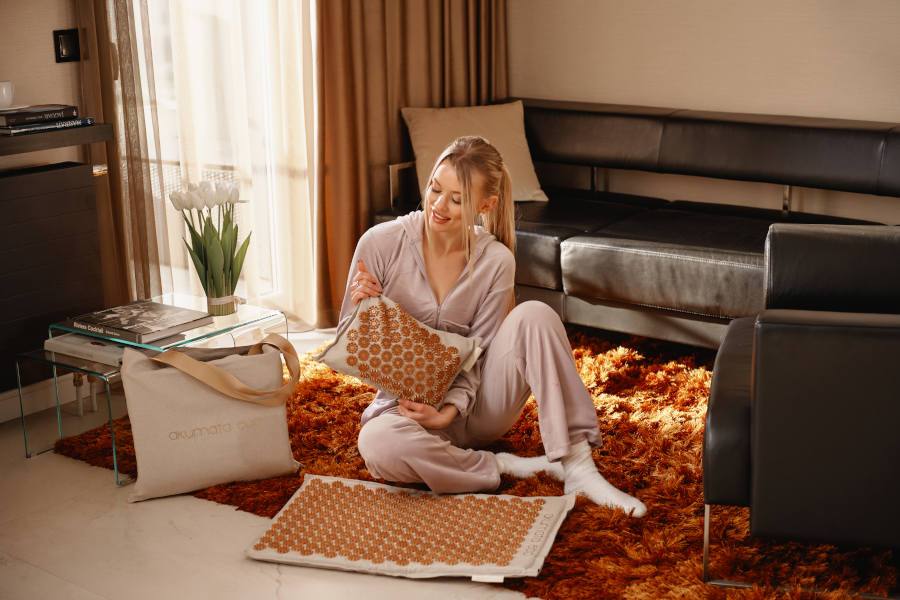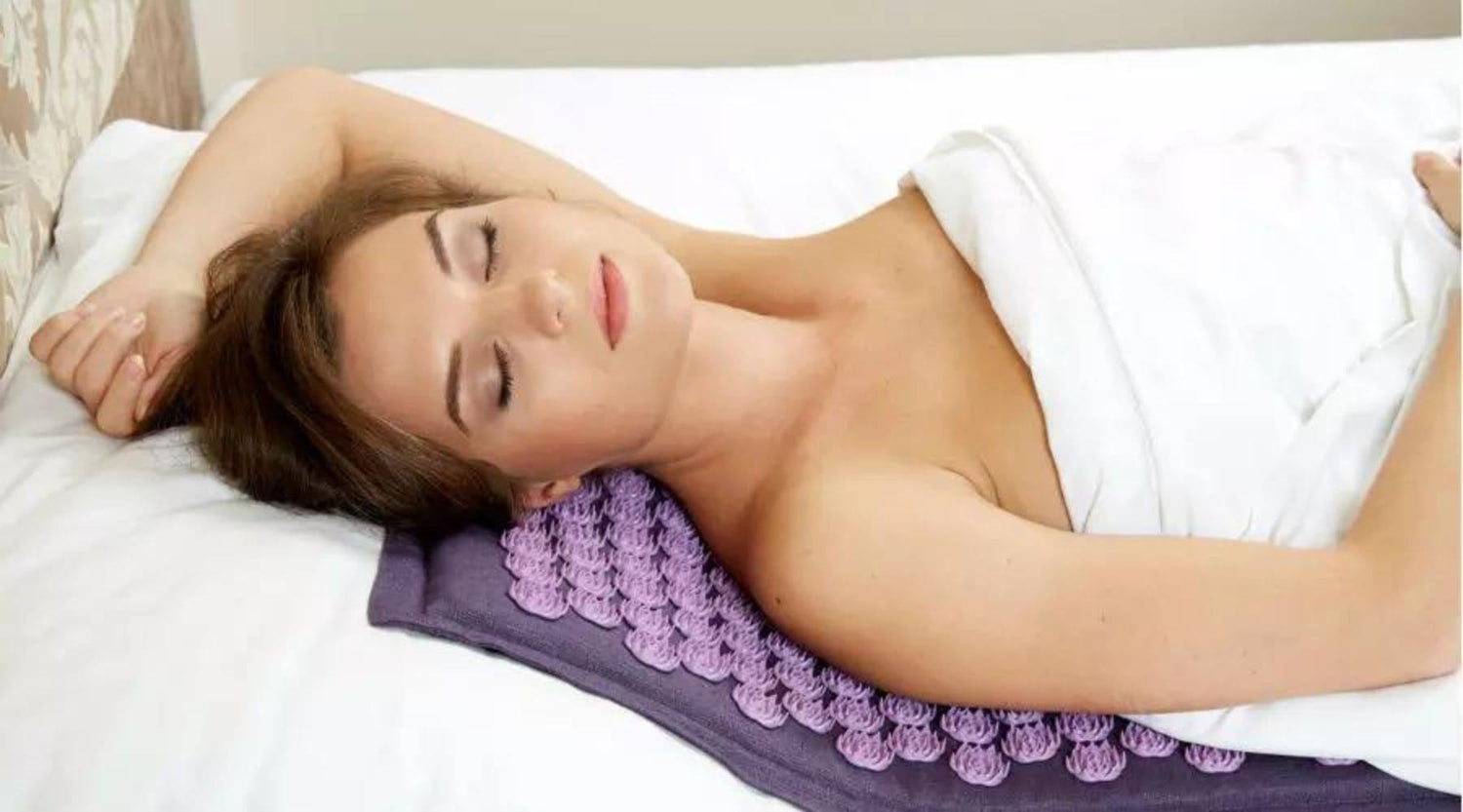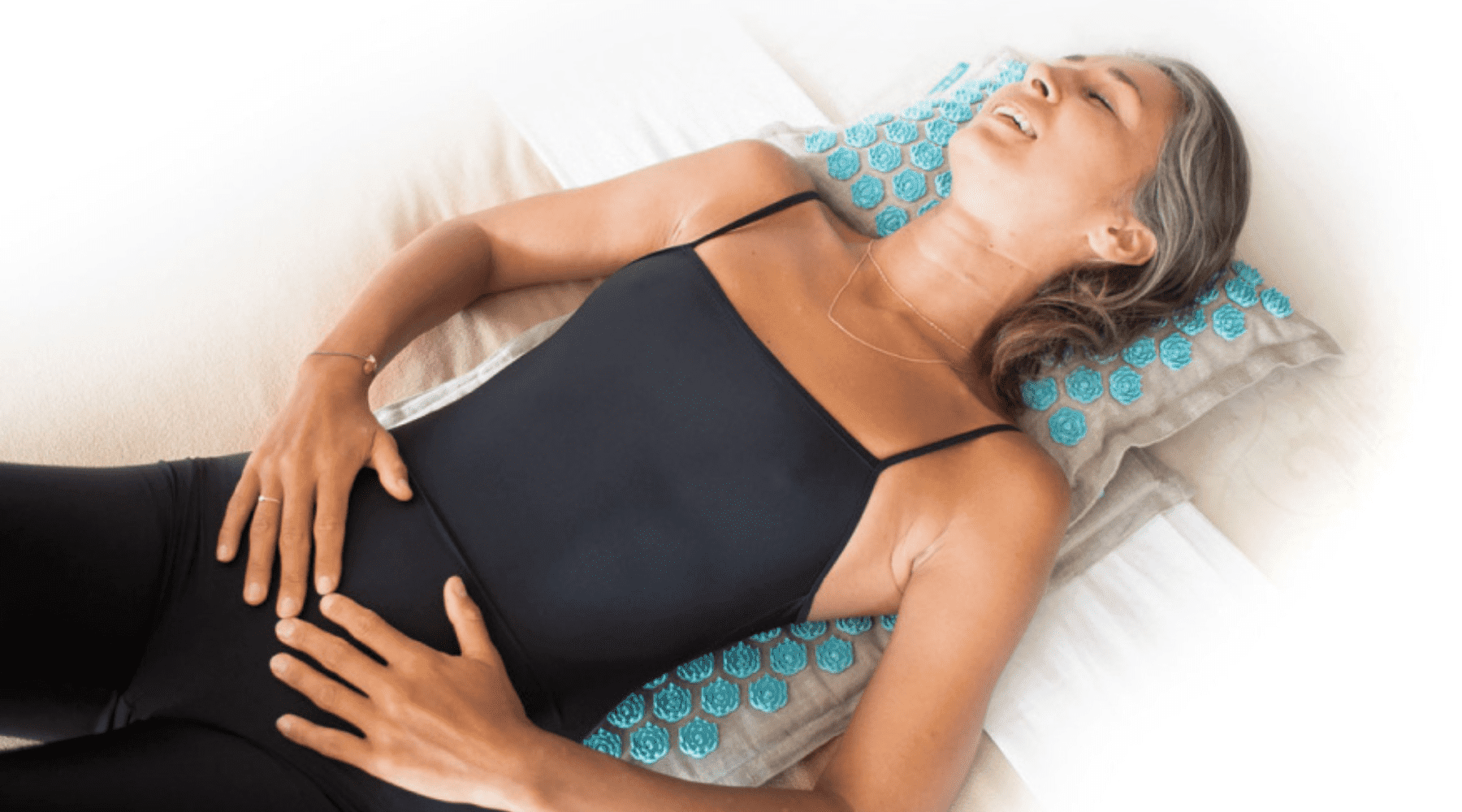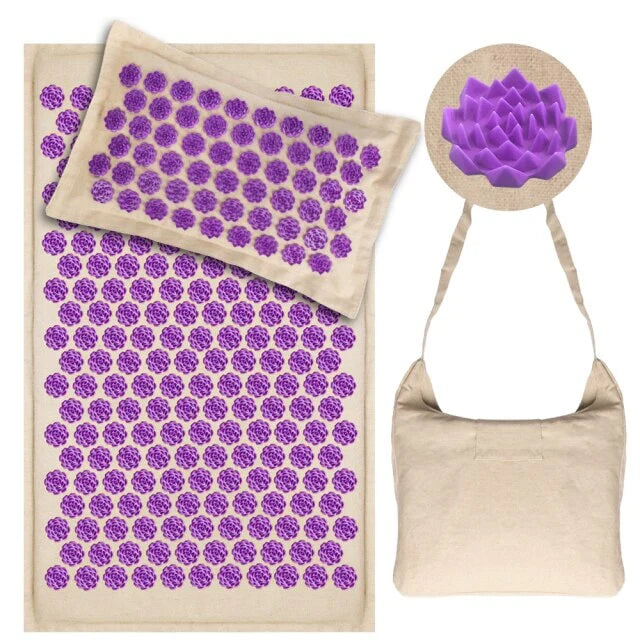Acupressure is frequently used to relax and release tension and has been shown to be an excellent stress management method.
Acupressure is a technique that, practically speaking, involves stimulating specific bodily regions, namely acupuncture sites and meridians.
This practice is beneficial for the immune system in many ways and is effective in rebalancing the body.
What is acupressure?
Acupressure is a form of manual therapy used to restore the balance of the meridians' vital energy. To achieve this, we press on particular acupuncture sites to stimulate them.
This method has its roots in conventional Chinese medicine. Knowing the acupressure points allows us to trigger them to treat common diseases. For instance, it is feasible to encourage sleep and combat tension and anxiety.

What are the acupressure points?
Our body is made up of 12 energy pathways, or "meridians," via which the Chi travels.
Our lungs, stomach, heart, bladder, heart master (or pericardium), gallbladder, large intestine, spleen, small intestine, kidneys, and liver are among the 11 that flow through our organs and viscera.
The Triple Warmer, or 12th Meridian, connects the body's three main points rather than one organ.

What are the benefits and advantages of acupressure?
Acupressure tries to enhance a physical, emotional, or mental condition by rebalancing the Chi and activating particular meridians. It is most frequently mentioned in:
- Stress management: by removing blockages, acupressure relaxes, fights stress and brings about a general well-being. It helps to calm nervous tension and to regain mental clarity.
- Strengthening the immune system: by facilitating circulation and strengthening the Chi, acupressure tends to improve the immune system. Stimulating certain points can neutralize negative energy to prevent certain ailments.
- Back pain: due to a bad posture, an injury, a great tension... the Chi circulates badly, causing an energetic imbalance of the back. In this case, acupressure will release the tensions and reactivate the circulation of the vital energy.
- Emotional balance: acupressure can be an interesting help for people who suffer from anxiety, phobias, depression or who have suffered an emotional shock. The manual therapy tends to rebalance the emotional balance of the person.
- Performance enhancement: the stimulation of certain meridians can prevent injuries in sports, strengthen physical endurance or improve recovery.

How to do acupressure against stress?
Experts advise placing the thumb and middle finger of one hand, or the middle finger and index finger of both hands, on the hollow located directly below the protuberance of the collarbones on the low and flat region.
This is where the R27 acupressure point is, and it does wonders to relieve tension in the mind.
Because these sites are sensitive, only light pressure should be used. Hold the posture for 30 to 60 seconds or until the pulsating stops.

How do you do acupressure for constipation?
You can gradually increase intestinal transit by activating the GI4 point, sometimes referred to as the "Union of the Valley." It is situated adjacent to the base of your thumb on the back of your hand.
Bring your thumb closer to your index finger to find the GI4 point precisely. It will appear as a little fleshy protrusion. Increase the pressure while making little circular motions, as long as it doesn't hurt. Do this for 1-2 minutes.

How to do acupressure for sleep?
Acupressure point stimulation can help to relax the mind so that it is easier to fall into Morpheus' arms. One hour before going to bed, press for one minute on a point under the foot in the middle of the arch and another point slightly above the ankle bone to accomplish this.

How to use acupressure to lose weight?
The stimulation of acupressure points can increase metabolism, reduce hyperphagia, and improve the cellulite-elimination process when combined with a healthy diet and regular exercise.
The outside of the leg, around four finger widths below the kneecap, has a spot that can be pressed to increase metabolism and aid in weight loss. For 30 to 60 seconds, stimulate.

How to do acupressure for digestion?
The GI4 point is also highly helpful in promoting digestion and preventing discomfort, heaviness, and other bloating.
How many sessions for results?
Even if the positive results can be noticed after the first session, the length of the therapy varies from person to person. On average, plan on 2 to 3 sessions.
What are the risks and contraindications?
A safe, gentle technique, acupressure carries no hazards. It may be used on young people, adults, and the elderly. On the other side, it shouldn't be done on skin that has been hurt or damaged, nor should it be done if someone has hemophilia or is on an anticoagulant.
It is advisable to consult a professional if you are ill or pregnant and need your doctor's approval. A therapist advises people with high blood pressure, heart disease, osteoporosis, inflammation, and cancer in particular.

Is the acupressure mat effective?
It is a spike-covered yoga mat or gym mat. They apply pressure to your back when you lie on it because of your weight.
They work to stimulate the relaxation centers while also relieving headaches, back pain (including sciatica, herniated discs, and scoliosis), and neck discomfort.
All of the mattress' surface is covered in pimples, which inevitably stimulate acupressure points and have therapeutic effects.
But given that the points are activated somewhat "randomly" based on your size, morphology, and position on the mattress, this mat cannot completely replace a session with a practitioner.

Who is acupressure for?
Acupressure is excellent for everyone who wishes to feel better by easing their difficulties, whether as a preventive or curative approach.
This method, which is an offshoot of acupuncture, is secure, non-intrusive, and most importantly, it results in genuine transformation.
After receiving an acupressure treatment, the patient should be able to achieve a certain level of harmony with their body and address any flaws.
Chinese medicine is continually being improved to lessen dysfunctions because it is aware of the issues people face every day as a result of various adjustments.

How to use an acupressure mat?
You need to bring a flower field mat since acupressure involves applying a precise amount of pressure to the body. With the use of weights and gravity forces similar to those of a real massage, this item can be used to achieve the same benefits as an acupressure mat.
As was already indicated, a practitioner is not necessary for this technique. All you have to do is use the floral field or acupressure mat. With the use of this mat, you can also release your "qi," which is termed "chi" in Chinese, without needing to visit a specialist's office.
You can feel relief and get rid of pain by releasing your body from the blockage.
The many points on an acupressure mat can be used to identify it. These pin-shaped points, which are frequently composed of plastic, work on particular regions of the back.
There are mats specifically for the neck, head, feet, and hands in addition to the back. Each point on the mat has been positioned and engineered to reduce pain in the user's body, particularly back and headache discomfort.
Acupressure mat, what benefits can you get from it?
You can use an acupressure mat without visiting a practitioner, which is its primary benefit. The mat can be used while you sit at home to ease your pain.
You can use your mat whenever you want, in addition to the shorter travel time. You can massage your points on yourself at any time, maintaining your independence.
Do you suffer from back pain? Do you have muscle strain or are you under stress? Use your acupressure mat without delay. How do you use an acupressure mat, exactly?
You need time to become familiar with the Flower Field Mat before you can respond to this question. You might initially experience pain. Nevertheless, you can get better with practice while still paying attention to the various points.

What are the most common acupressure points to learn?
Eight acupressure sites that are frequently used are listed below. To learn how to use each point and when to use it, click on its name.
Gallbladder 20 (GB20): Feng Chi
It is advised to focus on this point if you are experiencing migraines, headaches, cloudy or weary eyes, low energy, or cold or flu symptoms.
It can be found by palpating the mastoid bone (the ear bone) and tracing the groove to the area of the skull where the neck muscles attach.
Gallbladder 21 (GB21) : Jian Jing
With the thumb and middle finger, pinch the shoulder muscle to find this place. It is frequently used for stress, neck pain, headaches, facial pain, and teethaches. When around expectant mothers, use with care.
Large intestine 4 (LI4): He Gu
Stress, headaches, toothaches, neck discomfort, and facial pain can all be helped at this stage. It can, however, trigger labor and is never advised to be used when pregnant.
Liver 3 (VL3): Tai Chong
To find this point, you must take your shoe off. For stress, low back pain, high blood pressure, limb pain, sleeplessness, and emotional issues, this is a great area to stimulate.
Pericardium 6 (P6): Nei Guan
This point is also utilized to control heart palpitations and ease symptoms of motion sickness, nausea, anxiety, carpal tunnel syndrome, stomach aches, and migraines.
Triple Energizer 3: Zhong Zhu
This point is frequently utilized in clinical practice for temporal headaches, shoulder and neck stress, and upper back discomfort. It is situated in the groove created by the tendons of the fourth and fifth fingers, behind the joints.
Spleen 6 (SP6): San Yin Jiao
Numerous urological and pelvic conditions, as well as weariness and sleeplessness, can benefit greatly from understanding this point. Avoid while expecting.
Stomach36 (ST36) : Zu San Li
This point may be helpful for knee pain, stomach discomfort, exhaustion, and depression. This point is routinely stimulated by Asians to encourage longevity and good health.
Pick our acupressure mattress, acupressure cushion, acupressure ring and their carrying case for an easier acupressure practice.

Types of acupressure
The practice of massage dates back thousands of years. Today, there are over 80 different massage therapy types to choose from with a wide range of pressures, movements, and techniques.
These methods all include using the hands and fingers to press, rub, or manipulate muscles and other soft tissue. Even the feet, forearms, and elbows have been known to be used.
About 19% of Americans received massage therapy in 2018, according to the American Massage Therapy Association. They do it for a variety of reasons, as well.
More and more individuals are becoming aware of the health advantages of massage, especially baby boomers. They select from a variety of massage modalities to relieve symptoms, heal wounds, assist in the treatment of specific health issues, and enhance general wellbeing.
You may choose the ideal kind of massage for you with the help of the information provided here.

What are the best massage styles?
You may have observed that various massage modalities are in vogue at various points in time. And you might have questioned whether each one is really a fleeting trend or the most cutting-edge massage technique.
What's more, how can you tell if the newest massage technique will actually benefit you?
Long, flowing strokes and short, forceful ones are both employed in massage therapy. Oils and lotions are used by certain massage therapists but not by others.
For a massage, most massage therapists require their clients to undress, while some do not. A massage may last for five minutes or for two hours.
You need to ask yourself one question before you can choose the type of massage that is most effective for you. Do you merely desire a massage to unwind and manage your stress?
Or do you require symptom relief or assistance in treating a specific medical condition? Tell the massage therapist what you're looking for and inquire about the style before making a reservation.
Many people mix and match styles. Your age, health status, or particular needs or goals can all be taken into account when the therapist customizes your massage.
Here is a list of the most well-liked massage techniques. The first four are very well-liked.

1. Swedish massage
The Swedish massage therapy is the most popular kind of massage. Long, delicate kneading motions as well as quick, rhythmic tapping motions on the higher muscle layers make up this technique.
Additionally, joint movements are integrated with it. Swedish therapy can be calming and uplifting by releasing muscle tension. And it might even be beneficial following an accident.
Swedish massage involves four common types of strokes:
- Effleurage: a gentle, gliding motion used to relax soft tissue.
- Petrissage: the pressing, rolling or kneading that follows effleurage.
- Friction: deep circular movements that cause layers of tissue to rub against each other, which helps increase blood flow and break down scar tissue.
- Tapping: a short alternating tap with cupped hands, fingers or the edge of the hand.
- Deep tissue massage: the greatest approach to highlight certain "hot areas" in your body that are unpleasant and stiff is with a deep tissue massage. The massage therapist applies pressure to the layers of muscle, tendon, or other tissue deep beneath the skin with slow, deliberate strokes. Deep tissue massage can be helpful because it removes chronic stress and aids in the healing of muscular injuries like back sprains, while being less rhythmic than other types of massage.

2. Sports Massage
Sports massage includes a number of techniques to assist players in their training before, during, or after athletic events. Sports massage was created to help the muscle systems needed for a certain sport.
It can be used to increase flexibility and aid in injury prevention. Additionally, it can ease muscle tension and expedite the recovery process following a sports injury.

3. Chair massage
Have you ever envied those receiving chair massages at a conference, music festival, or county fair? Have you ever visited an airport's chair massage area?
Or maybe you're lucky enough to work for a company that routinely provides 15-20 minute massages. You receive a chair massage while seated and fully dressed in a portable chair that has been designed specifically for the purpose.
They often include a massage of the neck, shoulders, back, arms, and hands.

4. Shiatsu massage
Shiatsu is the Japanese word for finger pressure. Shiatsu massage involves the practitioner applying varied and rhythmic pressure to the body's strategic locations.
These places, known as acupressure sites, are regarded to be crucial for the movement of the body's life force, or chi. Practitioners of shiatsu massage assert that it can remove blockages at certain acupressure points.

5. Thai massage
In Thai massage, the therapist moves the client into various postures by using his or her own body. Muscle compression, joint mobilization, and acupressure are all included in this kind of massage.

6. Lymphatic drainage massage
A lymphatic drainage massage is a light touch tissue manipulation meant to promote the body's lymphatic fluid movement. A protein-rich fluid called lymph circulates through your body in lymphatic veins.
It gathers and transports waste materials, viruses, and germs to the lymph nodes. The fluid is subsequently filtered by the lymph nodes, which cleanse your body of contaminants.
To enhance the passage of lymph through your system, massage is often performed with light pressure and long, smooth strokes along the skin.

7. Hot Stone Massage
The therapist applies heated stones to specific body parts, such as acupressure points, during this sort of massage. The stones can be placed temporarily or utilized as massage implements.
Hot stones may be incredibly calming and relaxing when combined with other massage techniques since they deliver heat deep into the body.

8. Reflexology
Reflexology stimulates specific parts of the feet using hand, thumb, and finger movements. These regions are believed to correspond to various body sections. Therefore, the massage ought to encourage wellness.

9. Pregnancy massage
Your body experiences substantial changes while you are pregnant. Reducing tension, reducing swelling in the arms and legs, and soothing muscle and joint discomfort are all benefits of pregnancy massage that can help you adjust to these changes.
When prescription drugs and other medical treatments may be more constrained, massage can be extremely beneficial.
The massage therapist will assist you in finding a suitable position for this kind of treatment using pillows specifically made for that purpose.

What are the health benefits of acupressure?
Numerous massage techniques have advantages beyond simple relaxing. Here are a few conditions when massage therapy can be helpful. However, before utilizing massage for any health issue, see your doctor:
Back pain
More than one study has shown the effectiveness of massage therapy for back pain.

Headaches
Another type of pain "headaches" also respond to massage therapy. Some studies suggest that massage therapy can reduce a person's number of migraines and improve sleep.

Osteoarthritis
Participants who had a one-hour massage once or twice a week in the first clinical research on the benefits of Swedish massage for osteoarthritis of the knee reported reductions in pain, stiffness, and function. Such alterations did not occur in the control group.

Cancer
Massage, when used in conjunction with conventional Western medicine, can ease anxiety and lessen the effects of cancer treatment or its adverse effects.
For instance, it can aid in the reduction of discomfort or the improvement of immune system performance. However, there are some regions and circumstances where a massage therapist should completely avoid working on a cancer patient.
Consult your doctor before obtaining a massage if you have cancer.

Depression
According to a study of 17 clinical research, massage treatment can lessen depressive symptoms. However, it proved no more beneficial than offering a relaxing setting and deep breathing techniques for treating generalized anxiety disorder.









